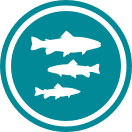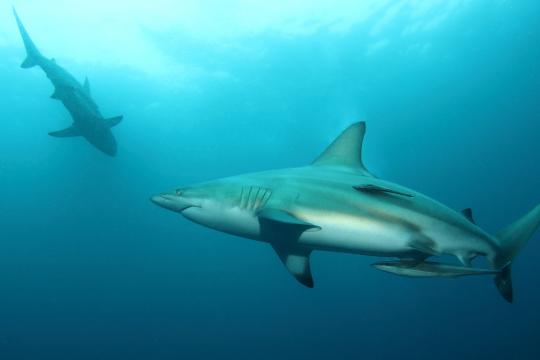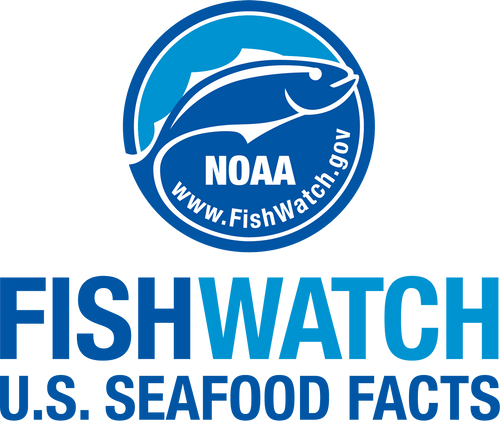Bonnethead Shark
 Bonnethead shark (Sphyra tiburo) on board the NOAA Ship Oregon II as part of the NOAA Teacher at Sea Program. Credit: NOAA Teacher at Sea Program/Bruce Taterka
Bonnethead shark (Sphyra tiburo) on board the NOAA Ship Oregon II as part of the NOAA Teacher at Sea Program. Credit: NOAA Teacher at Sea Program/Bruce Taterka
Bonnethead shark (Sphyra tiburo) on board the NOAA Ship Oregon II as part of the NOAA Teacher at Sea Program. Credit: NOAA Teacher at Sea Program/Bruce Taterka
About the Species
 Bonnethead shark (Sphyra tiburo) on board the NOAA Ship Oregon II as part of the NOAA Teacher at Sea Program. Credit: NOAA Teacher at Sea Program/Bruce Taterka
Bonnethead shark (Sphyra tiburo) on board the NOAA Ship Oregon II as part of the NOAA Teacher at Sea Program. Credit: NOAA Teacher at Sea Program/Bruce Taterka
Bonnethead shark (Sphyra tiburo) on board the NOAA Ship Oregon II as part of the NOAA Teacher at Sea Program. Credit: NOAA Teacher at Sea Program/Bruce Taterka
Bonnethead sharks are the smallest members of the hammerhead shark family, Sphyrnidae. Recognizable by their distinct shovel-shaped head, bonnethead sharks are found in warm, shallow coastal waters.
NOAA Fisheries manages bonnethead sharks as part of the small coastal shark complex, which also includes Atlantic sharpnose, Atlantic blacknose, and finetooth sharks.

Population
The Atlantic and Gulf of Mexico stocks have not been assessed. Although these population levels are unknown, management measures are in place.

Fishing Rate
Overfishing status is unknown, but catch is at recommended level.

Habitat Impact
Fishing gears used to harvest bonnethead sharks have minimal impacts on habitat.

Bycatch
Regulations are in place to minimize bycatch.
Population Status
There are two bonnethead shark stocks: an Atlantic stock and a Gulf of Mexico stock. A stock assessment for one overarching bonnethead shark stock was attempted in 2013 (SEDAR 34). However, because it was determined there were actually two stocks, the results of that assessment could not be used to support stock status. As a result,the population statuses of each stock are unknown. The fishing rate for each stock has been kept at the recommended level.
Appearance
Bonnethead sharks have gray, tan, or greenish upper bodies and paler bellies. Their backs and sides are often scattered with small dark spots. Their eyes are located on the rounded lobes of their shovel-shaped head, increasing their field of vision.
Biology
Female bonnethead sharks are typically larger than males. The species can reach an average of 3 to 4 feet, with a maximum length of about 5 feet. The heaviest recorded weight for a bonnethead shark is 24 pounds.
Bonnethead sharks are the only shark species that have a different head shape depending on their sex. Adult females have an evenly rounded head, while adult males have a distinct bulge in the center of their heads. This difference appears when males reach sexual maturity.
Female bonnethead sharks give birth to 4 to 14 live pups in late summer or early fall after a roughly 5-month gestation period. Pups measure around 12 inches at birth.
Bonnethead sharks are omnivores. In addition to fish, crabs, snails, and shrimp, they graze on seagrass.
Where They Live
Range
In the Atlantic Ocean, bonnethead sharks are primarily found off the coast of North Carolina to southern Brazil, including the Gulf of Mexico and Caribbean Sea. Although it’s rare, they have been seen as far north as Rhode Island.
In the Pacific Ocean, the species’ range spans from southern California to Ecuador. They are rarely seen north of San Diego.
Habitat
Bonnethead sharks live in shallow coastal waters over sandy or muddy bottoms, coral reefs, and grass flats. They are common in bays and estuaries.
Fishery Management
NOAA Fisheries manages sharks in federal waters under the Consolidated Atlantic Highly Migratory Species (HMS) Fishery Management Plan. Commercial, recreational, and for-hire fishermen must comply with permit requirements, trip limits, gear restrictions, finning prohibitions, closed areas, and reporting requirements to land bonnethead sharks.
Bonnethead sharks can only be sold to federally permitted shark dealers. Shark dealers are required to attend Atlantic shark identification workshops to help them better identify shark species.
Harvest
In 2022, commercial landings of bonnethead sharks totaled just over 2,800 pounds.
Scientific Classification
In the Atlantic Ocean, bonnethead sharks are primarily found off the coast of North Carolina to southern Brazil, including the Gulf of Mexico and Caribbean Sea. Although it’s rare, they have been seen as far north as Rhode Island.
In the Pacific Ocean, the species’ range spans from southern California to Ecuador. They are rarely seen north of San Diego.
Bonnethead sharks live in shallow coastal waters over sandy or muddy bottoms, coral reefs, and grass flats. They are common in bays and estuaries.
Fishery Management
NOAA Fisheries manages sharks in federal waters under the Consolidated Atlantic Highly Migratory Species (HMS) Fishery Management Plan. Commercial, recreational, and for-hire fishermen must comply with permit requirements, trip limits, gear restrictions, finning prohibitions, closed areas, and reporting requirements to land bonnethead sharks.
Bonnethead sharks can only be sold to federally permitted shark dealers. Shark dealers are required to attend Atlantic shark identification workshops to help them better identify shark species.
Harvest
In 2022, commercial landings of bonnethead sharks totaled just over 2,800 pounds.
Scientific Classification
| Kingdom | Animalia | Phylum | Chordata | Class | Chondrichthyes | Order | Carcharhiniformes | Family | Sphyrnidae | Genus | Sphyrna | Species | tiburo |
|---|
Last updated by NOAA Fisheries on 11/27/2024
Featured News
 Blacktip sharks. Credit: iStock.
Blacktip sharks. Credit: iStock.
 Releasing a sandbar shark on a shark survey.
Releasing a sandbar shark on a shark survey.
Recreational Fishing Regulations
These regulations apply to anglers targeting bonnethead sharks in federal waters off the coast of the eastern United States, in the Gulf of Mexico, and in the Caribbean Sea.
Permits
Vessels must have a valid Atlantic Highly Migratory Species (HMS) Angling or HMS Charter/Headboat permit to fish for bonnethead sharks. The permit covers everyone fishing on that vessel.
Tournament vessels may also fish for bonnethead sharks with an Atlantic Tunas General category or Swordfish General Commercial permit.
All HMS permit holders must have a shark endorsement on their permit before they can fish recreationally for bonnethead sharks.
Buy an HMS Angling or HMS Charter/Headboat permit
Renew an HMS Angling or HMS Charter/Headboat permit
Gear Restrictions
Anglers targeting bonnethead sharks must use handline or rod and reel gear with non-offset, non-stainless steel circle hooks, except when fishing with flies or artificial lures.
Minimum Size and Trip Limit
Permitted vessels can land one bonnethead shark per person on the fishing trip. There is no minimum size requirement for bonnethead sharks.
Landing Restrictions
Bonnethead sharks must be landed with their fins naturally attached. If an angler catches but doesn’t keep a shark, they must release it immediately, with minimal injury, and without removing it from the water.
Closed Areas
There are three areas closed to recreational bonnethead shark fishing for all or portions of the year. See the Atlantic HMS Recreational Compliance Guide for full details and geographic coordinates.
Reporting A Recreational Catch
There is no general reporting requirement for bonnethead sharks caught recreationally under an HMS Charter/Headboat or HMS Angling permit. However, anglers in Maryland must report all recreational shark landings to the state. North Carolina anglers must also report some pelagic shark species. Call the numbers below for more information:
- North Carolina Harvest Tagging Program: (800) 338-7804
- Maryland Department of Natural Resources: (410) 213-1531
Additionally, shark anglers are required to participate if contacted by a representative of the Large Pelagics Survey or Marine Recreational Information Program. You could be surveyed at the dock, by phone, or by mail.
Last updated by NOAA Fisheries on 11/27/2024
Commercial Fishing Regulations
These regulations apply to commercial fishermen targeting bonnethead sharks in federal waters off the coast of the eastern United States, in the Gulf of Mexico, and in the Caribbean Sea.
Permits
To commercially harvest or retain bonnethead sharks, vessel owners must have one of the following permits:
- Shark Directed permit
- Shark Incidental permit
- HMS Commercial Caribbean Small Boat permit (only for vessels measuring up to 45 feet long)
These three permits are issued by NOAA Fisheries’ Southeast Regional Office.
Charter and headboat vessels that want to sell their bonnethead shark catch must have a valid HMS Charter/Headboat permit with a commercial sale endorsement in addition to the appropriate commercial shark permit. The permit and endorsement can be obtained through the Atlantic HMS Permit Shop. They cover everyone fishing on that vessel.
Gear Restrictions
Fishermen with a directed or incidental shark permit are authorized to use these fishing gears:
- Bottom longline
- Pelagic longline
- Rod and reel
- Handline
- Bandit gear
- Gillnet
Visit the Atlantic Highly Migratory Species Commercial Compliance Guide for information on longline and gillnet restrictions and other gear-related requirements.
Minimum Size and Trip Limit
There is no minimum size requirement or species-specific trip limit for bonnethead sharks. Depending on the permit, vessels may be limited on how many total small coastal sharks they can retain, possess, land, or sell per trip.
Landing Restrictions
Bonnethead sharks must be landed with their fins naturally attached. If a fisherman catches but doesn’t keep a shark, they must release it immediately, with minimal injury, and without removing it from the water.
Closed Areas
Certain marine sanctuaries, special management zones, and time/area closures restrict the use of gear used to catch bonnethead sharks. Visit our commercial compliance guide for full details and geographic coordinates.
Catch Reporting
Selected fishermen are required to report fishing activities in an approved logbook within 48 hours of completing that day’s fishing activities—or before offloading if that is sooner. Fishermen selected for logbook reporting will receive a letter from NOAA Fisheries.
Reporting A Commercial Catch
Selected fishermen are required to report fishing activities in an approved logbook within 48 hours of completing that day’s fishing activities—or before offloading if that is sooner. Fishermen selected for logbook reporting will receive a letter from NOAA Fisheries.
Last updated by NOAA Fisheries on 11/27/2024
Seafood Facts

Is Bonnethead Shark Sustainable?
U.S. wild-caught bonnethead shark is a smart seafood choice because it is sustainably managed and responsibly harvested under U.S. regulations.
Availability
Year-round.
Source
U.S. wild-caught from North Carolina to Florida, the Gulf of Mexico, and Caribbean Sea.
Taste
Sweet, meaty taste.
Texture
Thick, large flakes and moist flesh.
Color
Raw meat is white to tan with a pink blood line
Health Benefits
Shark is a low-fat source of protein and is high in selenium and vitamins B6 and B12.
Nutrition Facts
Servings: 1; Serving Weight: 100 g (raw); Calories: 130; Protein: 20.98 g; Total Fat: 4.51 g; Total Saturated Fatty Acids: 0.925 g; Carbohydrate: 0 g; Total Sugars: 0 g; Total Dietary Fiber: 0 g; Cholesterol: 51 mg; Selenium: 36.5 mcg; Sodium: 79 mgMore Information
Last updated by NOAA Fisheries on 11/27/2024
Seafood News
 Chef Tyler Hadfield’s Curried Skate Wings with Tomato-Masala Chutney
Chef Tyler Hadfield’s Curried Skate Wings with Tomato-Masala Chutney
 NOAA Fisheries, in collaboration with Blue Ocean Mariculture, is conducting a multi-year pilot study to evaluate observational methods and tools for studying Hawaiian monk seal behavior. Courtesy of Blue Ocean Mariculture
NOAA Fisheries, in collaboration with Blue Ocean Mariculture, is conducting a multi-year pilot study to evaluate observational methods and tools for studying Hawaiian monk seal behavior. Courtesy of Blue Ocean Mariculture
 Tonya Wick aboard a fishing vessel at sea in 1998. Photo courtesy of Tonya Wick
Tonya Wick aboard a fishing vessel at sea in 1998. Photo courtesy of Tonya Wick
 Fish on display at the market. Credit: Shutterstock
Fish on display at the market. Credit: Shutterstock
Management Overview
NOAA Fisheries manages bonnethead sharks in federal waters of the Atlantic Ocean, including the Gulf of Mexico and Caribbean Sea, under the Consolidated Atlantic Highly Migratory Species (HMS) Management Plan. Individual states have their own rules and regulations for fishing in state waters, which extend to 3 miles from shore in the Atlantic and 9 miles from the shore in the Gulf of Mexico.
We manage bonnethead sharks as part of the small coastal shark complex. For commercial fishing, we’ve established combined annual quotas and catch limits for bonnethead, Atlantic sharpnose, and Atlantic finetooth sharks. This group is known in the regulations as “non-blacknose small coastal sharks,” and they are managed as two regional groups—Atlantic and Gulf of Mexico.
The commercial annual non-blacknose small coastal shark quota in the Atlantic region is 264.1 metric tons, dressed weight. In the Gulf of Mexico region, the quota is 112.6 mt dw.
The fishing season typically runs from January 1 to December 31. When commercial landings reach 80 percent of a regional quota and we expect landings to reach 100 percent of the regional quota by the end of the fishing season, the fishery is closed for the year.
The commercial Atlantic non-blacknose small coastal shark quota is linked to the Atlantic quota for blacknose sharks. If the landings for either group reach 80 percent of their regional quota, both commercial fisheries in the region are closed.
Read more about commercial fishing rules
The recreational bonnethead shark fishery is managed with retention limits. We do not open or close the fishery based on a quota.
Regulatory History
- 2023: NOAA Fisheries releases a review of the state of the Atlantic shark fishery that may be used to help develop future management measures and later releases an issues and options paper as a first step in reconsidering the appropriate management measures in the shark fishery.
- 2015: NOAA Fisheries adjusts the non-blacknose small coastal shark quotas and modifies the quota linkages between small coastal shark fisheries.
- 2013: NOAA Fisheries restructures the non-blacknose small coastal shark quota into regional quotas—Atlantic and Gulf of Mexico—and establishes quota linkages between management groups whose species are often caught together.
- 2013: A stock assessment determines that there are separate Atlantic and Gulf of Mexico stocks of bonnethead sharks. The stock status of the Atlantic and Gulf of Mexico stocks of bonnethead sharks are unknown.
- 2010: NOAA Fisheries establishes new small coastal shark complexes and quotas, and linked the blacknose and non-blacknose small coastal shark fisheries.
- 2008: NOAA Fisheries requires all shark fins remain naturally attached to the shark carcass through landing, sets a recreational trip limit of one bonnethead shark per person per trip with no minimum size, and establishes commercial trip limits for Shark Directed and Shark Incidental permit holders.
- 2007: A stock assessment supports a determination that bonnethead shark (as a single stock) is not overfished and not subject to overfishing.
- 2006: NOAA Fisheries releases the Consolidated Atlantic Highly Migratory Species Fishery Management Plan to manage all HMS fisheries.
- 2002: A stock assessment for the small coastal shark complex supports a determination that bonnethead shark (as a single stock) is not overfished and not subject to overfishing.
- 2001: NOAA Fisheries releases the United States National Plan of Action for the Conservation and Management of Sharks (PDF, 90 pages).
- 1999: NOAA Fisheries consolidates the management of Atlantic tunas, swordfish, and sharks under a single fishery management plan.
- 1997: NOAA Fisheries establishes a commercial quota for small coastal sharks and reduces the recreational trip limit for most shark species.
- 1993: NOAA Fisheries implements the first Fishery Management Plan for Sharks of the Atlantic Ocean. The plan includes a prohibition on shark finning.
- 1990: President George H.W. Bush signs the Fishery Conservation Amendments of 1990, which gives the Secretary of Commerce the authority to manage Atlantic highly migratory species, including sharks. The Secretary delegates this authority to NOAA Fisheries through the Highly Migratory Species Management Division.
- 1989: Fishery management councils ask the Secretary of Commerce to develop a shark fishery management plan that caps commercial fishing effort, establishes a recreational bag limit, prohibits shark finning, and establishes a data collection system.
- 1976: Congress passes the Fishery Conservation and Management Act. Under the act, Atlantic sharks are managed by regional fishery management councils.
Last updated by NOAA Fisheries on 11/27/2024
Science Overview
NOAA Fisheries conducts shark research from New England and the Mid-Atlantic to the South Atlantic and Gulf of Mexico, studying shark life history and performing long-term monitoring activities essential for stock assessment and management.
Tagging and Tracking Bonnethead Sharks
NOAA Fisheries runs the Cooperative Shark Tagging Program to study the life history of Atlantic sharks. Started in 1962, the program involves thousands of recreational and commercial fishermen, scientists, and fisheries observers. Participants tag large coastal and pelagic sharks and record information about the shark, such as the date and location where it was caught, the gear used, and the size and sex of the shark.
Shark Pupping and Nursery Surveys
We manage several surveys along the East Coast and in the Gulf of Mexico focused on shark nursery habitats in estuaries and nearshore water. The goals of these programs are to identify shark nursery habitat and determine and monitor species composition, habitat use, abundance, and distribution of sharks while they are present in these critical habitats.
The Cooperative Atlantic States Shark Pupping and Nursery Surveys are five annual surveys conducted from Delaware to Florida by federal agencies, state agencies and universities. The COASTSPAN program is overseen by the Northeast Fisheries Science Center.
More information about the COASTSPAN program
The Southeast Fisheries Science Center oversees the Gulf of Mexico States Shark Pupping and Nursery Area project, also known as GULFSPAN. The project is made up of four annual surveys conducted from Florida to Mississippi.
Last updated by NOAA Fisheries on 11/27/2024
Research
Apex Predator Publications and Reports – Bonnethead Shark
Publications and reports that include information on the bonnethead shark.
Last updated by NOAA Fisheries on 11/27/2024







